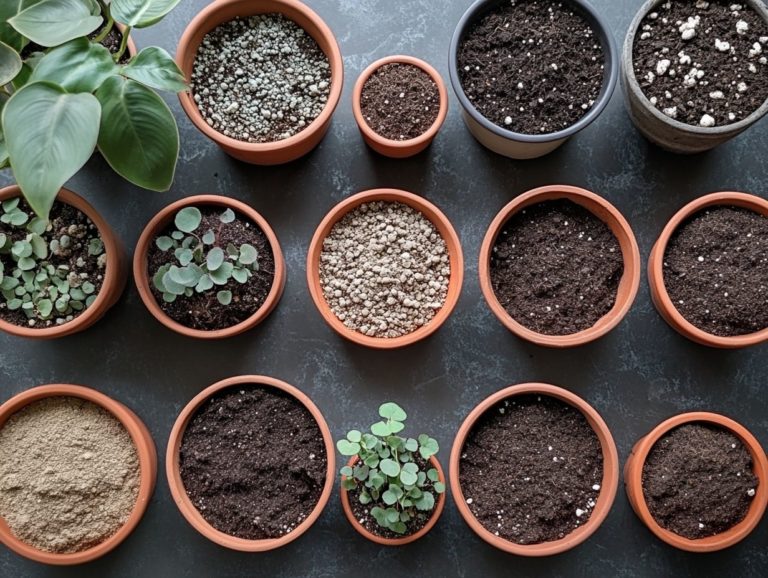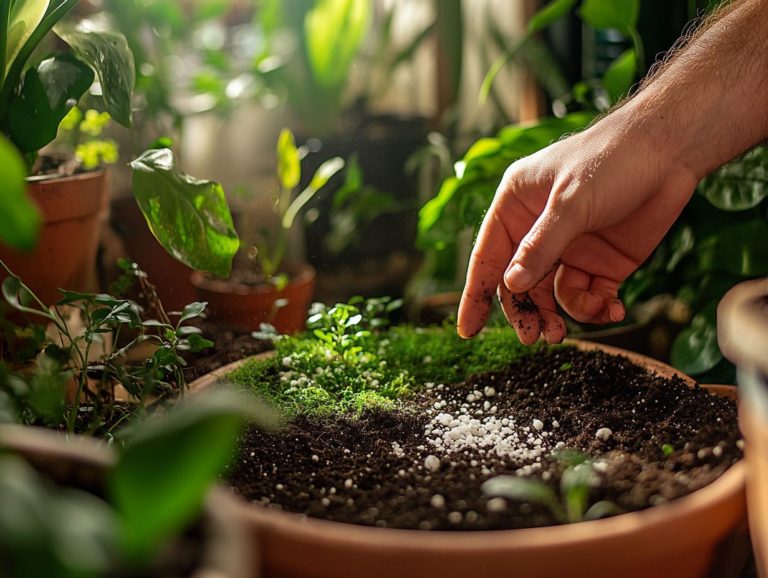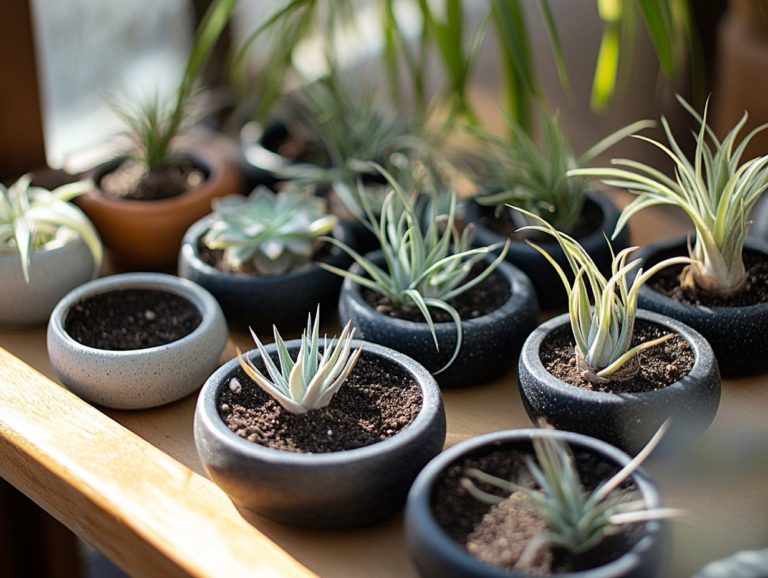How to Deal with Soil-borne Pests
Soil-borne pests can cause significant damage to your garden and crops, often lurking unnoticed until their impact is severe. To safeguard your plants, it s essential to understand these pests and the conditions that allow them to thrive. Get ready to discover powerful strategies to keep your garden safe!
This guide will introduce you to the common types of soil-borne pests, enabling you to identify and distinguish them with ease. With this knowledge in hand, you ll be well-equipped to protect your green spaces effectively!
Contents
- Key Takeaways:
- Understanding Soil-borne Pests
- Common Types of Soil-borne Pests
- Preventing Soil-borne Pests
- Controlling Soil-borne Pests
- Dealing with Infected Plants
- Frequently Asked Questions
- What are soil-borne pests and why are they a problem?
- How can I identify if I have soil-borne pests in my garden?
- What are some natural ways to deal with soil-borne pests?
- What are some chemical methods for controlling soil-borne pests and managing disease outbreaks?
- How can I prevent soil-borne pests and soilborne diseases from becoming a problem in my garden?
- Are there any specific plants, such as vegetable crops like tomatoes, potatoes, and cabbage, that are more susceptible to soil-borne pests?
Key Takeaways:

- Proper identification of soil-borne pests is crucial for effective prevention and control.
- Prevention is essential! Implementing strategies such as crop rotation and using disease-resistant plants can greatly reduce the risk of soil-borne pests.
- If your plants become infected, early detection and swift action are crucial in preventing the spread of the pests. Consider natural or chemical control methods to effectively manage the situation.
Understanding Soil-borne Pests
Understanding soil-borne pests is vital for preserving the health and productivity of your gardens and agricultural land. These tiny living things, including germs that cause diseases, can inflict considerable damage, leading to soil-borne diseases that jeopardize crop yields, especially in vegetable crops like tomatoes, potatoes, and cabbages.
By recognizing the impact these pests have on both soil and plant health, you can make informed decisions that pave the way for more successful outcomes in your gardens and farms.
What are Soil-borne Pests?
Soil-borne pests are those sneaky organisms that lurk beneath the surface, causing significant harm to plant health through various means, including the transmission of germs that lead to diseases like root decay.
Unlike their aerial counterparts, which inflict damage through feeding or invasive behaviors, soil-borne pests create challenges that are more subtle yet equally detrimental for gardeners and farmers. These include nematodes, fungi, bacteria, and various viruses that disrupt healthy root systems. The result? A range of distressing symptoms, such as wilting, yellowing leaves, and stunted growth.
When these germs invade the soil, they can compromise nutrient uptake, ultimately diminishing your plants’ vigor and yield. Understanding the nature of these pathogens and their effects on plant health is essential for devising effective pest management strategies.
Common Types of Soil-borne Pests
You may encounter a range of soil-borne pests, including various pathogens that can significantly affect crop production and plant health.
To effectively manage these diseases, implementing strategies like crop rotation and utilizing resistant varieties is essential. These practices are crucial in mitigating the risks posed by microorganisms that thrive in specific environmental conditions and can lead to disease outbreaks.
Identifying and Differentiating Pests

Identifying and differentiating pests starts with recognizing specific disease symptoms and understanding the infection rates associated with various pathogens, both of which can significantly impact your crop yield and plant health.
This process demands keen observation of visual clues such as wilting, discoloration, or stunted growth signs that may indicate the presence of soil-borne pests. To gain a clearer picture, utilizing laboratory tests like PCR (Polymerase Chain Reaction) and soil sampling will provide precise identification of pathogens.
Accurate pathogen identification is crucial for implementing effective pest management strategies. It allows for targeted treatment options, reducing unnecessary chemical applications and ultimately enhancing the resilience of your crops.
Preventing Soil-borne Pests
Preventing soil-borne pests is crucial for maintaining the health of your crops. This means using different methods, including thorough sanitation measures and thoughtful cultural practices. Efficient compost management is also essential, all designed to effectively suppress diseases.
Effective Prevention Strategies
Effective prevention strategies against soil-borne pests include crop rotation to disrupt pathogen reservoirs. Implementing sanitation measures minimizes the risk of disease introduction. This method boosts your crops’ defenses against diseases!
By alternating the types of crops you plant in specific areas, you can significantly reduce the likelihood of pests establishing themselves. Many soil-borne pathogens thrive on specific host plants.
Utilizing crop rotation tools, such as planning guides or digital applications, makes it easy for you to track crop cycles and streamline the rotation process.
Integrating beneficial organisms like helpful fungi that support plant roots and tiny roundworms that fight pests into your soil can further enhance its health. These organisms improve nutrient uptake and actively combat harmful pathogens, creating a resilient agricultural environment.
Controlling Soil-borne Pests
To effectively control soil-borne pests, you need a thoughtful blend of natural and chemical control methods. This tailored approach ensures that you address specific types of pathogens lurking in the soil while minimizing their spread.
By carefully selecting strategies that suit your unique situation, you can achieve a healthier soil ecosystem.
Natural and Chemical Control Methods

Natural control methods, like biological control, can beautifully complement the chemical applications detailed in the agricultural chemicals manual. This allows you to effectively manage soil-borne pests. Proper pathogen identification is crucial for selecting the right disinfestation methods.
For instance, introducing beneficial nematodes can significantly target and reduce populations of soil-dwelling insects. Using microbial agents such as Bacillus thuringiensis provides a natural way to tackle caterpillar pests.
On the flip side, judicious use of chemical fungicides can be beneficial in managing specific pathogens that threaten crop health.
Techniques like steam sterilization or solarization can physically eliminate unwanted organisms from the soil. This creates a healthier growing environment. By combining these practices, you enhance your pest management strategies and contribute to sustainable agriculture, reducing reliance on synthetic chemicals.
Dealing with Infected Plants
Dealing with infected plants requires you to be vigilant in recognizing the signs of infection. Once identified, you can implement effective treatment methods to manage the spread of soil-borne diseases and restore the health of your plants.
Recognizing and Treating Infected Plants
Recognizing and addressing infected plants requires a sharp awareness of disease symptoms, which can vary widely depending on the pathogens at play. This knowledge is crucial, as it directly impacts both crop yield and overall plant health.
For example, soil-borne pathogens like Fusarium and Pythium can lead to wilting, yellowing, and stunting of plants. Ultimately, this results in reduced productivity or even complete crop failure. Such symptoms often appear suddenly and require swift action.
Your treatment methods can include a range of strategies, such as using cultural practices like crop rotation and effective soil management to disrupt the life cycles of these pathogens. Additionally, learning how to handle indoor plant pest infestations can be crucial. Choosing resistant plant varieties can also greatly reduce the impact of these diseases, bolstering resilience against soil-borne infections.
By combining these approaches, you can significantly enhance the overall health of your crops. This paves the way for sustainable agricultural practices.
Frequently Asked Questions
Start monitoring your plants today to catch any issues early!
What are soil-borne pests and why are they a problem?

Soil-borne pests are insects, tiny worms that can harm plants, and other organisms that live and reproduce in the soil. They can cause significant damage to plants, leading to decreased crop yields and even plant death.
How can I identify if I have soil-borne pests in my garden?
One way to identify soil-borne pests is to look for visible signs of damage, such as wilting or yellowing leaves, stunted growth, or holes in plant leaves.
Try digging up a small section of soil around the affected plants to uncover these hidden pests!
What are some natural ways to deal with soil-borne pests?
Crop rotation is an effective natural method, where you plant different crops in the same area each year. This disrupts the life cycle of pests. Additionally, using beneficial insects like ladybugs and predatory mites can help control pest populations.
What are some chemical methods for controlling soil-borne pests and managing disease outbreaks?
Chemical methods include using pesticides that can be applied to the soil or directly onto plants.
Always read and follow instructions carefully to protect yourself, your plants, and beneficial organisms in your garden.
How can I prevent soil-borne pests and soilborne diseases from becoming a problem in my garden?
To prevent soil-borne pests, maintain healthy soil through proper fertilization and watering. Use clean and disease-free seeds or plants, and practice good sanitation by removing old plant debris and rotating crops.
Don t wait for problems to arise; act now to keep your garden healthy!
Are there any specific plants, such as vegetable crops like tomatoes, potatoes, and cabbage, that are more susceptible to soil-borne pests?
Yes, some plants are more vulnerable to soil-borne pests than others. For instance, vegetables like tomatoes, potatoes, and peppers are often targeted, along with ornamental plants like roses and marigolds.
Understanding which plants face the most risks helps you take proactive steps in your gardening journey!






